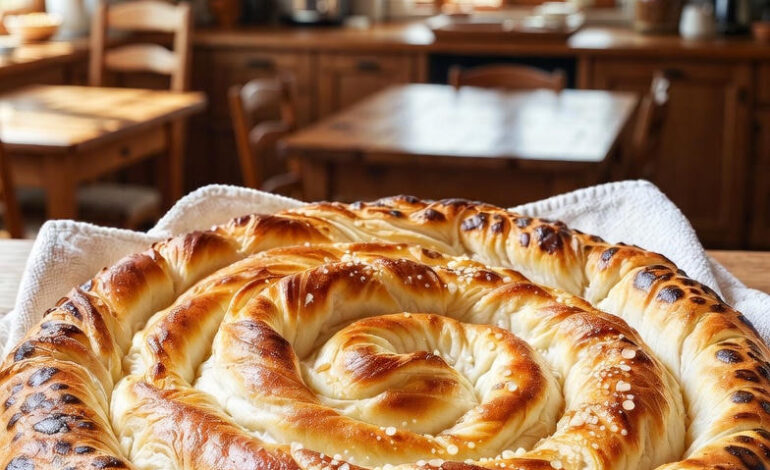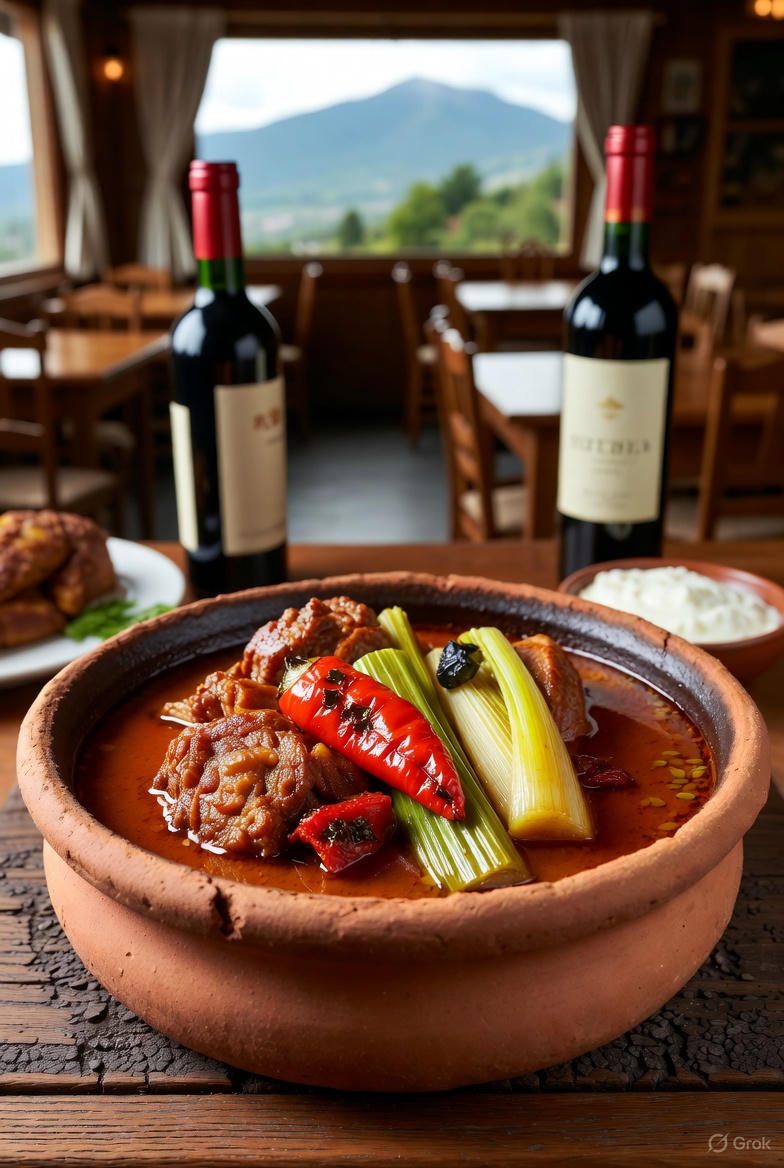Banitsa: The Soul of Bulgarian Cuisine – A Flaky, Comforting Masterpiece

In every corner of Bulgaria, from bustling Sofia cafés to remote mountain villages, the aroma of warm, buttery pastry layered with creamy cheese drifting from a wood-fired oven signals one thing: someone is making banitsa. This iconic dish is not merely food; it is ritual, memory, and identity rolled into delicate, golden coils. Ask any Bulgarian what their national dish is, and nine times out of ten the answer will be “banitsa” – often followed by a proud story about how their grandmother made the best one in the entire province.
A Brief History Baked in Layers
The roots of banitsa stretch back to the Thracians and Proto-Bulgars, but its modern form crystallized during the five centuries of Ottoman rule (1396–1878). The technique of stretching paper-thin phyllo-like dough (called kori in Bulgarian) was almost certainly introduced or perfected under Ottoman influence – the word itself echoes the Turkish börek. Yet Bulgarians took the concept and made it unmistakably their own, filling it with the white brine cheese (sirenje) produced by generations of shepherds in the Rhodope, Balkan, and Pirin mountains.
By the 19th century, banitsa had become inseparable from every major life event:
- Christmas Eve (Badni Vecher) – a coin or small dogwood twig with buds (symbolizing health and luck) is hidden in the pastry; whoever finds it will have good fortune.
- New Year’s Day – elaborate kǎshmětlǎk versions with multiple lucky charms (kusmeti).
- Weddings, name days, farewells, and funerals – there is always banitsa.
During the communist era (1944–1989), banitsa remained one of the few luxuries ordinary people could still make at home with rationed flour, oil, and homemade cheese. Street kiosks sold triangular slices wrapped in wax paper for a few stotinki, and grandmothers rolled metres of dough on tiny kitchen tables to feed entire apartment blocks.
Today, UNESCO-recognized “kifla” (a close cousin) may get international headlines, but in Bulgaria itself, banitsa reigns supreme.
The Classic Cheese Banitsa (Сирница) – Detailed Traditional Recipe
This is the gold standard: a spiral banitsa with sirenje (Bulgarian feta-style cheese) and eggs, baked until the top is leopard-spotted golden and the inside stays juicy.
Serves: 8–12 (one large 35–40 cm round tray) Preparation time: 1 hour 15 minutes (plus resting if you make your own dough) Baking time: 40–50 minutes at 180 °C (350 °F)
Ingredients
For the filling
- 500 g Bulgarian sirenje (white brine cheese) – if unavailable, use a 50/50 mix of good feta and ricotta for texture
- 4 large eggs (or 3 extra-large)
- 200 g plain Bulgarian or Greek yoghurt (full-fat, 4.5–10 %)
- 80–100 ml whole milk (adjust for desired juiciness)
- ½ tsp baking soda (traditional leavener that reacts with the yoghurt)
- Optional: a handful of finely chopped fresh dill or parsley
For the pastry Option A – Homemade “tocheni kori” (hand-stretched sheets, the real deal)
- 500 g all-purpose flour (type 500 in Bulgaria)
- 1 tsp salt
- 1 tsp vinegar or lemon juice
- 2 tbsp sunflower oil
- ~280–300 ml lukewarm water
Option B – Store-bought phyllo (perfectly acceptable, especially outside Bulgaria)
- 500–600 g fine Bulgarian or Greek phyllo (look for “kori za banitsa” – thinner than Greek commercial phyllo)
- 150–200 g unsalted butter, melted (or mix 100 g butter + 100 ml neutral oil)
For brushing and pouring
- 150–200 g melted butter (or butter-oil mix)
- 100–150 ml sparkling mineral water (the secret to extra fluffiness – many grandmothers swear by it)
Step-by-Step Instructions
1. Prepare the filling (5 minutes) Crumble the sirenje finely with a fork. Beat the eggs lightly, stir in the yoghurt and baking soda (it will foam slightly), then add the cheese. The mixture should be creamy but not runny. Add milk gradually until it looks like loose cake batter. Set aside.
2. If making homemade dough (the soul-satisfying way) Mix flour and salt in a large bowl. Make a well, add vinegar, oil, and most of the water. Knead 8–10 minutes until silky and elastic. Divide into 6–8 balls, brush generously with oil, cover, and rest 30–60 minutes. On a lightly floured tablecloth, stretch each ball with oiled hands until paper-thin and translucent. You should be able to read a newspaper through it.
3. Assemble the banitsa Preheat oven to 180 °C (350 °F), fan off if possible. Grease a 35–40 cm round metal tray (traditional “tepsiya”) generously with butter.
- Take one sheet of phyllo (or stretched dough). Brush lightly with melted butter.
- Spoon a thin line of filling along the longer edge, leaving 5 cm margins. Don’t overfill – about 3–4 tablespoons per sheet.
- Roll loosely into a cigar (loose rolls = fluffier result). Do not press.
- Place the first roll along the outer edge of the tray, curling it into a spiral. Continue with the remaining sheets, attaching each new roll to the end of the previous one until the tray is filled with a beautiful coiled snake.
- If you have leftover filling, pour it gently over the spiral.
4. The magic pouring step Mix 50 ml melted butter with 100–150 ml sparkling water. Pour evenly over the entire banitsa. Tilt the tray gently so the liquid seeps between the layers. This creates steam pockets and keeps the inside moist while the top crisps.
5. Bake Place on the lower rack. Bake 40–50 minutes until deep golden-brown with darker spots. If the top colours too fast, cover loosely with foil for the last 15 minutes.
6. The essential resting Remove from oven, spray or brush the surface with cold water, and cover with a clean kitchen towel for 15–20 minutes. This softens the top crust slightly and lets the layers settle into perfect tenderness.
Serving
Cut into wedges or squares. Serve warm (never hot – that’s how you burn your tongue on molten cheese). A bowl of cold homemade yoghurt on the side is practically mandatory.
Regional Variations Bulgarians Will Argue About Endlessly
- Tikvenik – pumpkin banitsa with cinnamon and walnuts (sweet, served at Christmas)
- Zelnik – filled with spinach, leek, or dock (lapad)
- Mlěchnik – sweet version with milk-egg custard instead of cheese
- Kashkavalka – layered with kashkaval yellow cheese, sometimes with ham
- Viti banitsi (twisted) vs ohlyuvi (snail-shaped) – fierce regional loyalties
In the Rhodope mountains they add rice to the cheese filling; in Dobrudzha they make enormous rectangular trays called praskana banitsa that puff up dramatically.
Final Thoughts
Banitsa is forgiving. Even a slightly torn phyllo sheet or uneven browning will taste magnificent. What matters is the love folded into every layer – and the inevitable second (or third) piece you’ll reach for before the tray has even cooled. In a country that has survived empires, wars, and earthquakes, banitsa remains unchanged: flaky, comforting, and utterly Bulgarian. One bite, and you understand why no holiday table, no train-station kiosk, and no grandmother’s kitchen is ever complete without it.
Dobǎr apetit! Or as Bulgarians say when the banitsa is particularly successful – Nazdrave!








